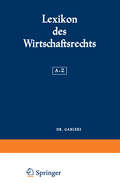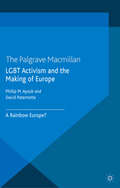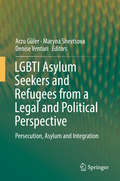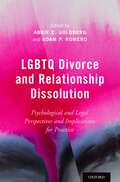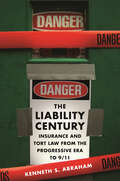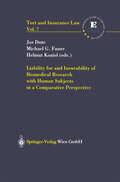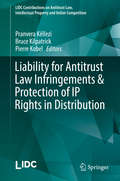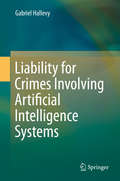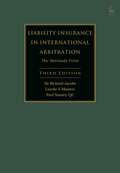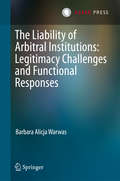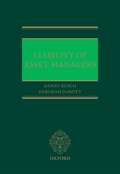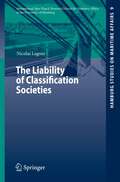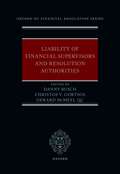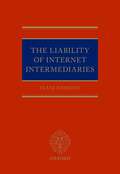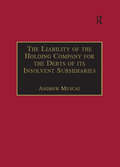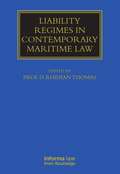- Table View
- List View
LGBT Activism and the Making of Europe: A Rainbow Europe? (Gender and Politics)
by David Paternotte Phillip AyoubThis book explores the alleged uniqueness of the European experience, and investigates its ties to a long history of LGBT and queer movements in the region. These movements, the book argues, were inspired by specific ideas about Europe, which they sought to realize on the ground through activism.
LGBTI Asylum Seekers and Refugees from a Legal and Political Perspective: Persecution, Asylum And Integration
by Arzu Güler Maryna Shevtsova Denise VenturiThis book addresses the ‘three moments’ in lesbian, gay, bisexual, transgender and intersex (LGBTI) asylum seekers’ and refugees’ efforts to secure protection: The reasons for their flight, the Refugee Status Determination process, and their integration into the host community once they are recognized refugee status.The first part discusses one of the most under-researched areas within the literature devoted to asylum claims based on sexual orientation and gender identity, namely the reasons behind LGBTI persons’ flight. It investigates the motives that drive LGBTI persons to leave their countries of origin and seek sanctuary elsewhere, the actors of persecution, and the status quo of LGBTI rights. Accordingly, an intersectional approach is employed so as to offer a comprehensive picture of how a host of factors beyond sexual orientation/gender identity impact this crucial first stage of LGBTI asylum seekers’ journey.In turn, the second part explores the challenges that LGBTI asylum seekers face during the RSD process in countries of asylum. It first examines these countries’ interpretations and applications of the process in relation to the relevant UNHCR guidelines and questions the challenges including the dominance of Western conceptions and narratives of sexual identity in the asylum procedure, heterogeneous treatment concerning the definition of a particular social group, and the difficulties related to assessing one’s sexual orientation within the asylum procedure. It subsequently addresses the reasons for and potential solutions to these challenges.The last part of the book focuses on the integration of LGBTI refugees into the countries of asylum. It first seeks to identify and describe the protection gaps that LGBTI refugees are currently experiencing, before turning to the reasons and potential remedies for them.
LGBTQ Divorce and Relationship Dissolution: Psychological and Legal Perspectives and Implications for Practice
by Abbie E. Goldberg and Adam P. RomeroWhat unique challenges face LGBTQ individuals in relationships or who are separating or divorcing, especially now that same-sex couples may marry? What issues might complicate the ending of relationships when children, multiple partners, or multiple parents are present? How do gender, gender transition, ethnicity, immigration status, economic status, geography, and other characteristics shape the experiences of divorcing or separating LGBTQ people? Finally, how can therapists and lawyers most effectively assist LGBTQ people whose relationships and families are dissolving? LGBTQ Divorce and Relationship Dissolution: Psychological and Legal Perspectives and Implications for Practice brings together social science and legal perspectives to examine the timely topic of relationship dissolution and divorce among sexual and gender minorities. The first edited book to tackle this topic in an informed, comprehensive, and interdisciplinary matter, this volume gathers and expands current knowledge on topics such as LGBTQ people's relationship and dissolution patterns; the divorce and child custody rules and processes that now apply to many LGBTQ families; and the surrounding political and cultural environment in the United States. It will also address practical issues such as mediation with same-sex couples who are separating or divorcing, financial planning, and family therapy for sexual minority parents and their children in the context of divorce/dissolution. With chapters contributed by leading scholars and practitioners from law, political science, psychology, sociology, and other disciplines, LGBTQ Divorce and Relationship Dissolution will be an invaluable resource for academics, practitioners, policymakers, and LGBTQ people. It will also be of interest to students in psychology, counseling, law, and LGBTQ and gender studies.
LGBTQ Divorce and Relationship Dissolution: Psychological and Legal Perspectives and Implications for Practice
What unique challenges face LGBTQ individuals in relationships or who are separating or divorcing, especially now that same-sex couples may marry? What issues might complicate the ending of relationships when children, multiple partners, or multiple parents are present? How do gender, gender transition, ethnicity, immigration status, economic status, geography, and other characteristics shape the experiences of divorcing or separating LGBTQ people? Finally, how can therapists and lawyers most effectively assist LGBTQ people whose relationships and families are dissolving? LGBTQ Divorce and Relationship Dissolution: Psychological and Legal Perspectives and Implications for Practice brings together social science and legal perspectives to examine the timely topic of relationship dissolution and divorce among sexual and gender minorities. The first edited book to tackle this topic in an informed, comprehensive, and interdisciplinary matter, this volume gathers and expands current knowledge on topics such as LGBTQ people's relationship and dissolution patterns; the divorce and child custody rules and processes that now apply to many LGBTQ families; and the surrounding political and cultural environment in the United States. It will also address practical issues such as mediation with same-sex couples who are separating or divorcing, financial planning, and family therapy for sexual minority parents and their children in the context of divorce/dissolution. With chapters contributed by leading scholars and practitioners from law, political science, psychology, sociology, and other disciplines, LGBTQ Divorce and Relationship Dissolution will be an invaluable resource for academics, practitioners, policymakers, and LGBTQ people. It will also be of interest to students in psychology, counseling, law, and LGBTQ and gender studies.
LGBTQI Inclusivity, Homosexuality, and Same-Sex Marriage in the Catholic Church: Pope Francis’s Synodal Theology, Sociology, and Moral Issues
by Vivencio O BallanoThis book employs an experimental approach to critically re-examine the Catholic Church’s traditional teachings on homosexuality, heterosexual marriage, and Lesbian, Gay, Bisexual, Transgender, Queer, and Intersexual (LGBTQI) inclusivity in light of Pope Francis’s inductive synodal theology and modern sociology. With the growing complexity of today’s culture and the advancement of social science research, it argues that the empirical foundations of the traditional Church’s doctrines on topical moral issues need to be scientifically re-assessed, so as to update them in view of Francis’s synodality and sociological research on gender, sexuality, and same-sex union. Discussion pertaining to whether homosexuality is naturally disordered and whether heterosexuality is the only criterion for Christian marriage remain lingering empirical issues in the Church that require a sociological and inductive synodal analysis, rather than the traditional deductive philosophical and theological method that is largely based on natural law theory. This topical book is of appeal to scholars and students of sociology, theology, as well as religious, biblical, and gender studies.
The Liability Century: Insurance and Tort Law from the Progressive Era to 9/11
by Kenneth S. AbrahamKenneth Abraham explores the development and interdependency of the tort liability regime and the insurance system in the United States during the twentieth century and beyond, including the events of September 11, 2001.From its beginning late in the nineteenth century, the availability of liability insurance led to the creation of new forms of liability, heavily influenced expansion of the liabilities that already existed, and continually promoted increases in the amount of money that was awarded in tort suits. A “liability-and-insurance spiral” emerged, in which the availability of liability insurance encouraged the imposition of more liability, and, in turn, the imposition of liability encouraged the further spread of insurance.Liability insurance was not merely a source of funding for ever-greater amounts of tort liability. Liability insurers came to dominate tort litigation. They defended lawsuits against their policyholders, and they decided which cases to settle, fight, or appeal. The very idea behind insurance––that spreading losses among large numbers of policyholders is desirable––came to influence the ideology of tort law. To serve the aim of loss spreading, liability had to expand.Today the tort liability and insurance systems constantly interact, and to reform one the role of the other must be fully understood.
Liability for and Insurability of Biomedical Research with Human Subjects in a Comparative Perspective (Tort and Insurance Law #7)
Recent Dutch legislation has been introduced stating that biomedical research on humans can only be undertaken when an insurance contract covering the damage as a result of death or personal injury of the patients has been concluded. The aim of this legislation is to ease the acquiring of compensation for test subjects in case damage arises in the course of biomedical research. As such, victims are able to claim compensation directly from the insurer, irrespective of any liability. This volume presents a critical evaluation of the functioning of this legislative arrangement and the situation in various European countries is examined. Country reporters from Belgium, England, France, Germany, the Netherlands, Spain, Sweden and Switzerland describe the insurance and liability arrangements relating to biomedical research in their country. The concluding three reports of this volume examine the situation from both a comparative and international perspective.
Liability for Antitrust Law Infringements & Protection of IP Rights in Distribution (LIDC Contributions on Antitrust Law, Intellectual Property and Unfair Competition)
by Bruce Kilpatrick Pierre Kobel Pranvera KëlleziThis book gathers international and national reports from across the globe on key questions in the field of antitrust and intellectual property.The first part discusses the allocation of liability for infringement of antitrust laws between corporations and individuals. The book explores the criminal or administrative sanctions available against corporations, companies or group of companies, and individuals, such as employees or directors. A detailed international report explores the major trends and challenges in this field and provides an excellent comparative study of this complex and challenging subject.The second part examines whether intellectual property rights are sufficiently protected to ensure a fair return on investments made by manufacturers and distributors. This question comes at a time where distribution is facing deep and radical changes with the Internet. To what extent this is an opportunity or a threat to the sustainability of distribution systems of differentiated and IP protected goods is the question. This book brings together the current legal responses across a number of European countries and elsewhere in the world, all summarised and elaborated in an international report.The book also includes the resolutions passed by the General Assembly of the International League of Competition Law (LIDC) following a debate on each of these topics, which include proposed solutions and recommendations. The LIDC is a long-standing international association that focuses on the interface between competition law and intellectual property law, including unfair competition issues.
Liability for Crimes Involving Artificial Intelligence Systems
by Gabriel HallevyThe book develops a general legal theory concerning the liability for offenses involving artificial intelligence systems. The involvement of the artificial intelligence systems in these offenses may be as perpetrators, accomplices or mere instruments. The general legal theory proposed in this book is based on the current criminal law in most modern legal systems.In most modern countries, unmanned vehicles, sophisticated surgical systems, industrial computing systems, trading algorithms and other artificial intelligence systems are commonly used for both industrial and personal purposes. The question of legal liability arises when something goes wrong, e.g. the unmanned vehicle is involved in a car accident, the surgical system is involved in a surgical error or the trading algorithm is involved in fraud, etc. Who is to be held liable for these offenses: the manufacturer, the programmer, the user, or, perhaps, the artificial intelligence system itself?The concept of liability for crimes involving artificial intelligence systems has not yet been widely researched. Advanced technologies are forcing society to face new challenges, both technical and legal. The idea of liability in the specific context of artificial intelligence systems is one such challenge that should be thoroughly explored.
Liability for Transboundary Pollution at the Intersection of Public and Private International Law (Hart Monographs in Transnational and International Law)
by Guillaume LaganièreThis book focuses on how public and private international law address civil liability for transboundary pollution. In public international law, civil liability treaties promote the implementation of minimum procedural standards in domestic tort law. This approach implicitly relies on private international law to facilitate civil litigation against transboundary polluters. Yet this connection remains poorly understood. Filling the gap, this book engages in a meaningful dialogue between the two areas and explores how domestic private international law can reflect the policies developed in international environmental law. It begins with an investigation of civil liability in international environmental law. It then identifies preferable rules of civil jurisdiction, foreign judgments and choice of law for environmental damage, using Canadian private international law as a case study and making extensive references to European law. Liability for transboundary pollution is a contentious issue of the law, both in scholarship and practice: international lawyers both private and public as well as environmental lawyers will welcome this important work.
Liability for Transboundary Pollution at the Intersection of Public and Private International Law (Hart Monographs in Transnational and International Law)
by Guillaume LaganièreThis book focuses on how public and private international law address civil liability for transboundary pollution. In public international law, civil liability treaties promote the implementation of minimum procedural standards in domestic tort law. This approach implicitly relies on private international law to facilitate civil litigation against transboundary polluters. Yet this connection remains poorly understood. Filling the gap, this book engages in a meaningful dialogue between the two areas and explores how domestic private international law can reflect the policies developed in international environmental law. It begins with an investigation of civil liability in international environmental law. It then identifies preferable rules of civil jurisdiction, foreign judgments and choice of law for environmental damage, using Canadian private international law as a case study and making extensive references to European law. Liability for transboundary pollution is a contentious issue of the law, both in scholarship and practice: international lawyers both private and public as well as environmental lawyers will welcome this important work.
Liability for Wrongful Interferences with Chattels
by Simon DouglasThe book examines the protection of property rights in chattels through the law of torts, focusing on the four actions of conversion, detinue, trespass and negligence. Traditionally these actions have been governed by arcane divisions which have led to unnecessary complexity and arbitrariness. The principal argument made in the book is that significant developments in the modern law point towards abolition of these arcane divisions and permit the chattel torts to be understood by reference to a coherent and justifiable structure. It is argued that the only division which should be drawn in the modern chattel torts is between intentional interferences with chattels, where liability is strict, and unintentional interferences with chattels, where liability is fault based. In order to demonstrate this structure it is first argued that the actions of conversion, detinue and trespass amount, in substance, to a single cause of action which imposes strict liability for the intentional interference with another's chattel. It is then argued that the tort of negligence recognises a fault-based cause of action for the unintentional interference with another's chattel. It is further argued that this basic structure, unlike the arcane divisions which have traditionally governed this area of law, can be justified.
Liability for Wrongful Interferences with Chattels
by Simon DouglasThe book examines the protection of property rights in chattels through the law of torts, focusing on the four actions of conversion, detinue, trespass and negligence. Traditionally these actions have been governed by arcane divisions which have led to unnecessary complexity and arbitrariness. The principal argument made in the book is that significant developments in the modern law point towards abolition of these arcane divisions and permit the chattel torts to be understood by reference to a coherent and justifiable structure. It is argued that the only division which should be drawn in the modern chattel torts is between intentional interferences with chattels, where liability is strict, and unintentional interferences with chattels, where liability is fault based. In order to demonstrate this structure it is first argued that the actions of conversion, detinue and trespass amount, in substance, to a single cause of action which imposes strict liability for the intentional interference with another's chattel. It is then argued that the tort of negligence recognises a fault-based cause of action for the unintentional interference with another's chattel. It is further argued that this basic structure, unlike the arcane divisions which have traditionally governed this area of law, can be justified.
Liability Insurance in International Arbitration: The Bermuda Form
by Lorelie S Masters Richard Jacobs Qc Paul Stanley QcThis is the third revised edition of what was described by the English Court of Appeal in C v D as the “standard work” on Bermuda Form excess insurance policies. The Form, first used in the 1980s, covers liabilities for catastrophes such as serious explosions or mass tort litigation and is now widely used by insurance companies. It is unusual in that it includes a clause requiring disputes to be arbitrated under English procedural rules in London but subject to New York substantive law. This calls for a rare mix of knowledge and experience on the part of the lawyers involved, each of whom is required to confront the many differences between English and US law and legal culture. In addition, since the awards of arbitrators are confidential and are not subject to the scrutiny of the courts, the book helps professionals understand the Form's lengthy and complex provisions. The book, first published in 2004, was the first comprehensive analysis of the Bermuda Form. It is frequently cited in Bermuda Form arbitrations and was the joint winner in 2012 of British Insurance Law Association Book Prize for the most notable contribution to literature in the field of law as it affects insurance. It offers a detailed commentary on how the Form is to be construed, its coverage, the substantive law to be applied, the limits of liability, exceptions, and, of course, the procedures to be followed during arbitration proceedings in London. The book will prove invaluable to lawyers, risk managers, and executives of companies which purchase insurance on the Bermuda Form, and to clients, lawyers or arbitrators involved in disputes arising therefrom.
The Liability of Arbitral Institutions: Legitimacy Challenges and Functional Responses
by Barbara Alicja WarwasThis book offers an innovative approach to the topic of liability in international arbitration, a controversial topic that has heretofore not been fully explored in the scholarship. Arbitral institutions have recently emerged as powerful actors with new functions in and outside arbitration processes. The author proposes to shift the debate on liability from arbitrators to the arbitral institutions. The book re-evaluates the orthodox understanding of the status, functions, and responsibility of arbitral institutions and is recommended for arbitration scholars, practitioners, and students. It is argued that the current regulations regarding liability are inadequate given both the contractual obligations and the emerging public function of arbitral institutions and that institutional arbitral liability is therefore necessary. The book also links the contemporary functions of arbitral institutions to recent debates regarding legitimacy challenges in international commercial arbitration. Responding to these challenges, a model of institutional contractual liability is proposed that invites arbitral institutions to proactively regulate the scope of their liability.
Liability of Asset Managers
Given the international nature of the asset management industry, lawyers representing investors, asset managers, and regulators are often confronted with asset management agreements governed by foreign law. This book provides the necessary points of law and practice in the leading jurisdictions allowing lawyers to identify the main pitfalls concerning the foreign law in question. This book is the only comparative analysis of the law of asset manager liability in the major European jurisdictions, the United States, and Canada, each written by specialists from the relevant jurisdiction. This is a much-needed guide on the disparate regulation of asset manager liability in these countries highlighting the absence of uniformity in this area of law despite the implementation of MiFID in Europe. The section on European law provides an overview of the regulation in this field regionally and provides the context in which the national chapters explore the regulation at country level. The comparative evaluation at the end of the book provides a thoughtful assessment of the impact of regulatory frameworks on asset managers private law duties and liabilities. The Introduction situates the country-by-country material within the broader context of questions about regulatory design and effectiveness.
The Liability of Classification Societies (Hamburg Studies on Maritime Affairs #9)
by Nicolai I. LagoniBecause the liability of ship owners is limited, classification societies have been considered as exempt from liability. This book analyses which actions of classification societies may give rise to claims and whether or not the societies can be held liable under English, German or American maritime law. In addition, it develops the fundamental aspects of an international convention on the limitation of the liability of classification societies.
Liability of Financial Supervisors and Resolution Authorities (Oxford EU Financial Regulation)
by Danny Busch, Christos V. Gortsos and Gerard Mcmeel QcSince the global financial crisis of 2008, claims by clients, shareholders, depositors, and bondholders of financial firms have increased against financial supervisors and resolution authorities for inadequate supervision or resolution action. Liability of Financial Supervisors and Resolution Authorities is the first book to offer a thorough and systematic analysis of the liability regimes which apply to financial supervisors and resolution authorities at the EU level (particularly relevant since the European Banking Union came into operation in 2014), at the level of individual EU Member States, as well as in other major jurisdictions worldwide. The jurisdiction-by-jurisdiction approach provides a detailed analysis of the liability regimes as they apply to local financial supervisors and resolution authorities in major civil law, common law, and mixed legal system jurisdictions. This global view of the primary financial jurisdictions as examples provides a unique and comprehensive overview which is of great practical and theoretical importance. The work concludes with a comparative law evaluation that discusses to what extent limitations of the liability of national financial supervisors and resolution authorities are valid under the EU rules on Member State liability. It also explores whether it would be preferable to adopt a uniform liability standard for the European Central Bank (ECB), the Single Resolution Board (SRB), and national financial supervisors and resolution authorities. Furthermore, it addresses whether it would be preferable to adopt a provision to the effect that the Court of Justice of the European Union has exclusive jurisdiction in relation to the ECB, SRB, and the national financial supervisors and resolution authorities.
Liability of Financial Supervisors and Resolution Authorities (Oxford EU Financial Regulation)
Since the global financial crisis of 2008, claims by clients, shareholders, depositors, and bondholders of financial firms have increased against financial supervisors and resolution authorities for inadequate supervision or resolution action. Liability of Financial Supervisors and Resolution Authorities is the first book to offer a thorough and systematic analysis of the liability regimes which apply to financial supervisors and resolution authorities at the EU level (particularly relevant since the European Banking Union came into operation in 2014), at the level of individual EU Member States, as well as in other major jurisdictions worldwide. The jurisdiction-by-jurisdiction approach provides a detailed analysis of the liability regimes as they apply to local financial supervisors and resolution authorities in major civil law, common law, and mixed legal system jurisdictions. This global view of the primary financial jurisdictions as examples provides a unique and comprehensive overview which is of great practical and theoretical importance. The work concludes with a comparative law evaluation that discusses to what extent limitations of the liability of national financial supervisors and resolution authorities are valid under the EU rules on Member State liability. It also explores whether it would be preferable to adopt a uniform liability standard for the European Central Bank (ECB), the Single Resolution Board (SRB), and national financial supervisors and resolution authorities. Furthermore, it addresses whether it would be preferable to adopt a provision to the effect that the Court of Justice of the European Union has exclusive jurisdiction in relation to the ECB, SRB, and the national financial supervisors and resolution authorities.
The Liability of Internet Intermediaries
by Jaani RiordanInternet intermediaries play a central role in modern commerce and society. Although their economic and social importance is well-recognised, their legal liability remains poorly understood, and, until now, no work has specifically addressed their legal responsibility for wrongdoing carried out by third parties using their facilities or platforms. This work fills that gap by providing comprehensive coverage of the legal duties owed by intermediaries and the increasingly complex schemes that regulate their activities. The first part of the work introduces the concept of an internet intermediary, general doctrines of primary and secondary liability, and the European enforcement regime. The second part examines the liability of intermediaries in specific areas of law, with a detailed analysis of the applicable liability rules, and the major English case law, and decisions of the Court of Justice that interpret and apply them. The final part of the work provides guidance on remedies and limitations. Written by an expert author from the intellectual property chambers at 8 New Square, Lincoln's Inn, this is an essential guide for lawyers advising on liability, privacy, and online regulation.
The Liability of Internet Intermediaries
by Jaani RiordanInternet intermediaries play a central role in modern commerce and society. Although their economic and social importance is well-recognised, their legal liability remains poorly understood, and, until now, no work has specifically addressed their legal responsibility for wrongdoing carried out by third parties using their facilities or platforms. This work fills that gap by providing comprehensive coverage of the legal duties owed by intermediaries and the increasingly complex schemes that regulate their activities. The first part of the work introduces the concept of an internet intermediary, general doctrines of primary and secondary liability, and the European enforcement regime. The second part examines the liability of intermediaries in specific areas of law, with a detailed analysis of the applicable liability rules, and the major English case law, and decisions of the Court of Justice that interpret and apply them. The final part of the work provides guidance on remedies and limitations. Written by an expert author from the intellectual property chambers at 8 New Square, Lincoln's Inn, this is an essential guide for lawyers advising on liability, privacy, and online regulation.
The Liability of the Holding Company for the Debts of its Insolvent Subsidiaries
by Andrew MuscatThis work deals with the liability of the holding company for the debts of its insolvent subsidiaries. In analyzing the current position under English law, the work challenges as outmoded and inadequate the virtual dogma that a holding company is not answerable for the debts of its insolvent subsidiaries. The study identifies four separate and distinct types of behavioural practices within corporate groups which may prejudice the interests of external creditors or otherwise constitute an abuse of the corporate form; the subservient subsidiary situation; the inadequately financed subsidiary situation; the integrated economic enterprise situation; and the group persona situation. After weighing the various arguments for and against a change in the law and concluding that reform is called for, the study proceeds to submit some radical proposals for reform. The basic thrust of the reform proposals is that in a number of well-defined situations entity law should give way to an enterprise analysis and holding company liability should be imposed for the debts of insolvent subsidiaries.
The Liability of the Holding Company for the Debts of its Insolvent Subsidiaries
by Andrew MuscatThis work deals with the liability of the holding company for the debts of its insolvent subsidiaries. In analyzing the current position under English law, the work challenges as outmoded and inadequate the virtual dogma that a holding company is not answerable for the debts of its insolvent subsidiaries. The study identifies four separate and distinct types of behavioural practices within corporate groups which may prejudice the interests of external creditors or otherwise constitute an abuse of the corporate form; the subservient subsidiary situation; the inadequately financed subsidiary situation; the integrated economic enterprise situation; and the group persona situation. After weighing the various arguments for and against a change in the law and concluding that reform is called for, the study proceeds to submit some radical proposals for reform. The basic thrust of the reform proposals is that in a number of well-defined situations entity law should give way to an enterprise analysis and holding company liability should be imposed for the debts of insolvent subsidiaries.
Liability Regimes In Contemporary Maritime Law (PDF)
by D. Rhidian ThomasThis book addresses the topical and current issues in maritime law and brings them together into a coherent strand by the common perspective of liabilities for the professional reader. Liability Regimes in Contemporary Maritime Law appeals to both the industry and the legal profession and provides a degree of analysis and discussion, while also bringing together in a single volume the essential interest in a range of individual subject areas.
